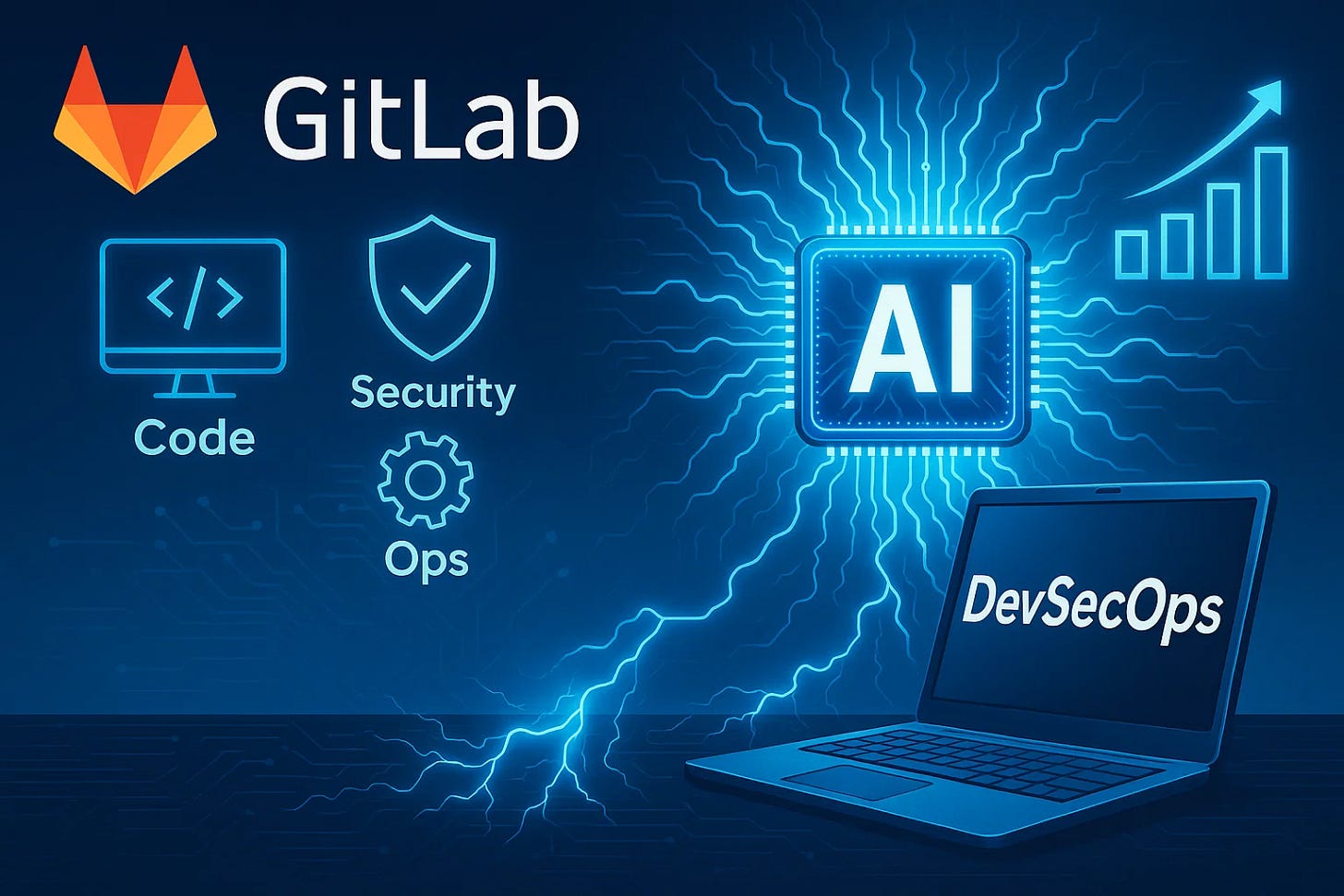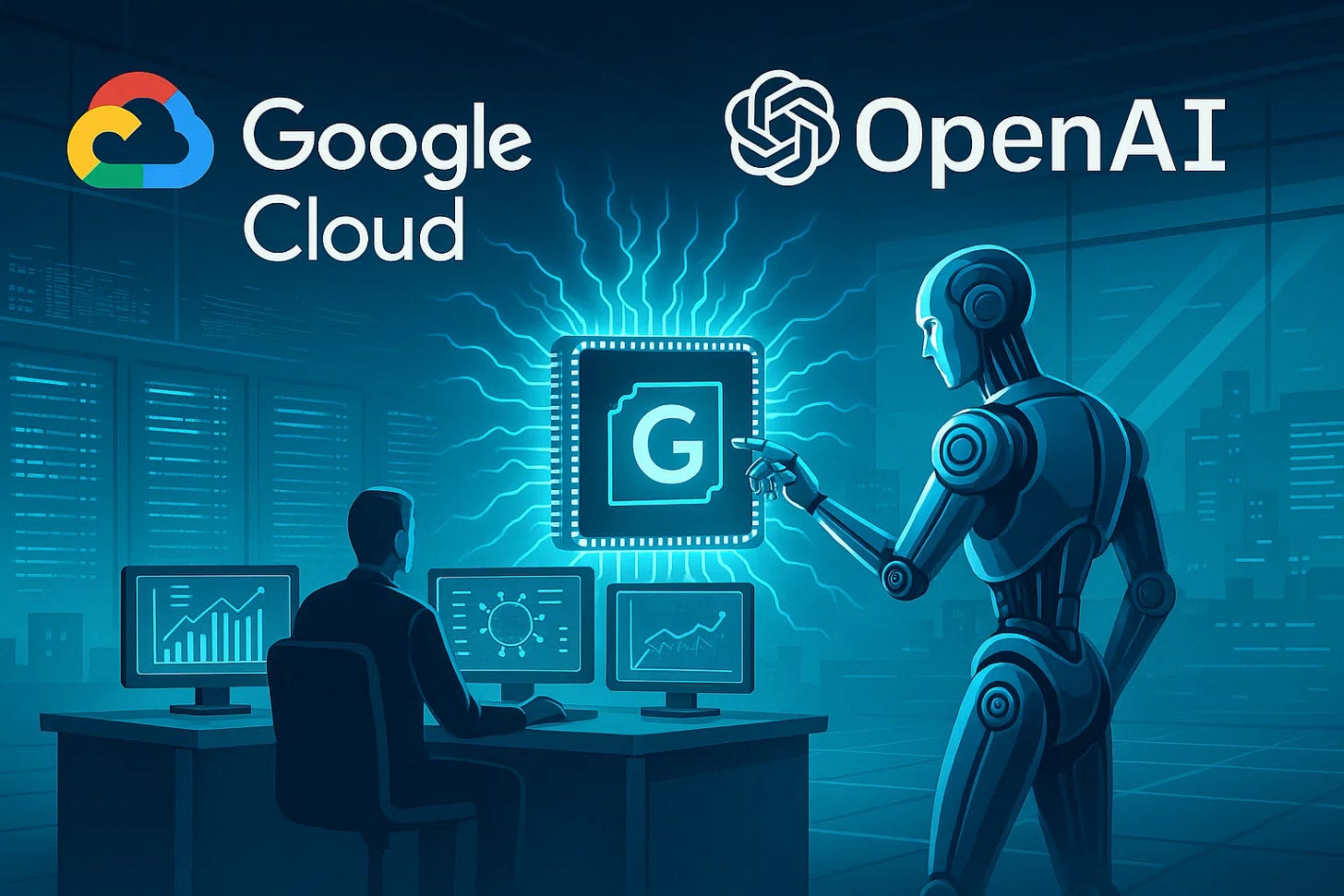GitLab’s Margin Breakthrough, Google-OpenAI Cloud Coup & NVIDIA’s Sovereign Superchip Surge
Welcome, AI & Semiconductor Investors,
GitLab delivered a 12% non-GAAP operating margin on 27% revenue growth, OpenAI reportedly inked its first Google deal to ease Azure reliance, and Germany’s Blue Lion supercomputer chose NVIDIA’s upcoming Vera Rubin architecture, signaling a new era of national-scale AI compute.— Let’s Chip In
What The Chip Happened?
💻 AI-Native DevSecOps Pays Off, but Top-Line Beat Stays Skinny
🚀 Google Lands OpenAI Overflow Deal: TPUs Take Center Stage in Cloud Arms Race
🔧 Vera Rubin Super-Chips Ignite the Sovereign-AI Supercomputer Race
[GitLab Lifts the Hood on Q1 FY 2026: 27 % Revenue Growth and Record Cash Flow]
Read time: 7 minutes
Get 15% OFF Finchat — MY FAVORITE STOCK MARKET DATA PLATFORM —
GitLab (NASDAQ: GTLB)
💻 AI-Native DevSecOps Pays Off, but Top-Line Beat Stays Skinny
What The Chip: On June 10, 2025, GitLab reported Q1 FY 2026 results that kept its growth streak alive, with revenue up 27% year-over-year (YoY) to $214.5 million and a non-GAAP operating margin swinging to +12%. Management leaned hard on the message that its AI-native, model-neutral DevSecOps platform is turning into a must-have as enterprises race to embed generative AI in software pipelines.
The Situation Explained:
📈 Revenue & Guidance – Q1 sales $214.5 M (+27% YoY); FY-26 outlook $936-942 M (+24%)—unchanged, signaling caution on macro even after a record free-cash-flow quarter.
💸 Cash Machine – Adjusted FCF hit $104.1 M (49% margin), driven by SaaS mix (30% of revenue, +35% YoY) and back-loaded deal timing. GitLab now sits on $1.1 B in cash.
🤖 Duo Momentum – Customers buying GitLab Duo (AI chat + code suggestions) up 35% QoQ; Duo Enterprise private-beta users report 35% faster test generation and 25% quicker RCA. Duo Workflow (agentic AI) moves to public beta this summer, GA in winter.
🔐 Ultimate Pull-Through – Ultimate tier is 52% of ARR, with 8 of the 10 biggest Q1 deals landing there. Security features and compliance dashboards remain the upgrade hook.
🏛️ FedRAMP Win – GitLab Dedicated earned FedRAMP Moderate authorization; management expects a public-sector tailwind (NatWest and FBI already expanding on Dedicated).
🤝 AWS Partnership – New integration embeds Amazon Q agents in GitLab; Volkswagen Digital Solutions cites “dramatically reduced context-switching.” Joint GTM blitz planned for AWS Global Summits.
🧮 KPIs – DBNRR 122% (80 pts seat growth, 15 pts tier upgrades, 5 pts yield); 10,104 customers > $5 K ARR, 1,288 > $100 K (+26% YoY). Net new logo adds slowed at the low end, reflecting SMB price sensitivity.
⚠️ Bearish Flags – “Skinniest” top-line beat since IPO; guidance unchanged despite positive CRPO; heavy seat growth still leaning on last quarter’s megadeal; AI competitors (Cursor, Replit, Windsor) crowd the dev-assist space. Management notes customers are “buying multiple tools” to compare.
📊 JiHu Drag – China JV still consolidated; FY-26 expense estimate $18 M (vs. $13 M FY-25). De-consolidation timing remains uncertain.
Why AI/Semiconductor Investors Should Care: The company is positioning itself as the operating layer where that AI-accelerated code lives. Margin expansion (+1,400 bps YoY) and FCF generation prove the model can scale even while it seeds Duo features in paid tiers for free to drive adoption.
The near-term bear case is a decoupling between strong profit optics and a cautious 24% revenue guide—suggesting seat growth could cool if hiring or macro tightens. The bull case: agentic AI (Duo Workflow) could unlock a new per-user/per-task consumption lever, allowing GitLab to monetize compute cycles, not just seats, as AI-assisted development volume explodes.
Get 15% OFF Finchat — MY FAVORITE STOCK MARKET DATA PLATFORM —
Alphabet Inc. (NASDAQ: GOOGL)
🚀 Google Lands OpenAI Overflow Deal: TPUs Take Center Stage in Cloud Arms Race
What The Chip: Reuters reports that In May 2025, OpenAI quietly signed a multi-year agreement to burst workloads onto Google Cloud—the first time the ChatGPT maker has relied on a direct rival for core infrastructure. The pact chips away at Microsoft Azure’s former exclusivity and underscores just how extreme generative-AI compute demand has become.
The Situation Explained:
🤖 Compute crunch goes nuclear — Token generation grew ≈13× in 18 months, pushing ChatGPT past 500 M weekly users and 3 M+ paying orgs. OpenAI needs every accelerator it can find.
🔗 Multi-cloud hedging — Google joins Azure, CoreWeave, and Oracle’s “Stargate” project—giving OpenAI four distinct clouds and two chip lines (Nvidia GPUs & Google TPUs) to juggle.
💸 ARR bankrolls the burst — OpenAI’s annualized revenue just hit $10 B, up from $5.5 B six months ago and tracking toward $12.7 B for FY-25—enough gross profit to fund parallel clouds without deepening losses.
📈 Win for Google Cloud — Alphabet’s cloud arm booked $43 B in 2024 sales (12 % of total). Scotiabank called the deal “a big win,” adding high-margin AI workload batched to Google’s in-house TPUs.
🔋 Capacity still tight — Alphabet CFO Anat Ashkenazi told analysts Google “already lacked sufficient capacity” last quarter. Alphabet plans $75 B in AI-driven cap-ex for 2025 to keep pace.
🛠️ Custom-silicon subplot — OpenAI finalizes its first in-house accelerator design later this year, raising the stakes for Nvidia and Google alike.
Why AI/Semiconductor Investors Should Care: OpenAI’s deal widens the TAM for hyperscale cloud and accelerator vendors rather than shrinking it. Google gains a flagship customer that potentially could validate TPU economics, Microsoft retains a hefty spend but loses lock-in leverage, and Nvidia still ships the lion’s share of silicon even as TPUs nibble at the edge. With OpenAI’s $10 B+ run-rate funding compute-hungry growth, expect sustained hyperscale cap-ex, continued GPU/TPU shortages, and rising interest in alternative accelerators through at least the foreseeable future.
Nvidia (NASDAQ: NVDA)
🔧 Vera Rubin Super-Chips Ignite the Sovereign-AI Supercomputer Race
What The Chip: On June 10, 2025, Germany’s Leibniz Supercomputing Centre confirmed its upcoming Blue Lion supercomputer will run on NVIDIA’s new Vera Rubin architecture — the Rubin GPU plus Vera CPU launching in 2H 2026. Hours later, Lawrence Berkeley National Lab underscored the trend with its own Doudna system. Together they spotlight how governments now treat AI compute as strategic infrastructure.
The Situation Explained:
🔹 30× More Muscle in Munich — Blue Lion will deliver ~30 × the compute of SuperMUC-NG, cooled by HPE’s fan-less warm-water Cray chassis and recycling waste heat to nearby buildings.
🧬 Doudna Doubles Down on Efficiency — Berkeley’s machine targets 10 × higher application performance using only 2-3 × the power — a 3-5 × jump in performance per watt for fusion, genomics and materials science.
⚡ Unified CPU-GPU Design — Vera Rubin fuses NVIDIA’s first custom CPU with its next-gen GPU over shared memory, slashing data-movement bottlenecks and letting simulations, data crunching and AI inference run in the same memory space.
🌍 Sovereign-AI Tailwind — CEO Jensen Huang calls AI factories “the new power plants.” Nations from the U.K. to Germany are budgeting billions for local LLM training and cultural data sovereignty, expanding demand beyond hyperscalers.
🔗 Sticky Software Moat — Rubin’s tight link to CUDA, Quantum-X800 InfiniBand and in-network acceleration deepens platform lock-in versus rival CPU+GPU pairings.
⚠️ Watch the Timeline — First Rubin shipments land 2H 2026; any delay could open a window for AMD’s next MI400-series or custom ASIC challengers.
Why AI/Semiconductor Investors Should Care: Sovereign-AI projects funnel government budgets into multiyear, on-prem GPU deployments, cushioning any cyclical pause in cloud-provider spend. Vera Rubin cements NVIDIA’s architectural lead and broadens its datacenter TAM, while deeper hardware-software integration fortifies switching costs. If Rubin meets its efficiency claims, NVIDIA could extend datacenter gross-margin strength just as Blackwell ramps — a potent combo for long-term earnings growth.
Youtube Channel - Jose Najarro Stocks
X Account - @_Josenajarro
Get 15% OFF Finchat — MY FAVORITE STOCK MARKET DATA PLATFORM
Disclaimer: This article is intended for educational and informational purposes only and should not be construed as investment advice. Always conduct your own research and consult with a qualified financial advisor before making any investment decisions.
The overview above provides key insights every investor should know, but subscribing to the premium tier unlocks deeper analysis to support your Semiconductor, AI, and Software journey. Behind the paywall, you’ll gain access to in-depth breakdowns of earnings reports, keynotes, and investor conferences across semiconductor, AI, and software companies. With multiple deep dives published weekly, it’s the ultimate resource for staying ahead in the market. Support the newsletter and elevate your investing expertise—subscribe today!
[Paid Subscribers] GitLab Lifts the Hood on Q1 FY 2026: 27 % Revenue Growth and Record Cash Flow
Date of Event: June 10, 2025
Executive Summary
*Reminder: We do not talk about valuations, just an analysis of the earnings/conferences
All-Remote-GitLab Inc. (NASDAQ: GTLB) rang in fiscal 2026 with a headline revenue increase of 27 % year-over-year to $214.5 million for the quarter ended April 30 2025. Management paired that top-line surge with a 12 % non-GAAP operating margin, a dramatic swing from a 2 % loss a year ago, and unlocked $104 million in adjusted free cash flow, an all-time high.
Chief Executive Officer Bill Staples credited the performance to GitLab’s “AI-native DevSecOps platform,” telling investors, “We’re giving every developer the AI-driven edge they need to innovate faster and more efficiently.” Chief Financial Officer Brian Robins added that the company’s platform approach “continues to drive momentum,” as evidenced by record cash generation and margin expansion.
Key first-quarter metrics highlight the runway:
Gross margins: 90 % on a non-GAAP basis, only a point below last year despite rapid SaaS growth.
Customer mix: 1,288 clients now generate over $100,000 in annual recurring revenue (ARR), up 26 % year-over-year; overall customers above $5,000 ARR rose to 10,104.
Retention: Dollar-based net retention stayed a healthy 122 %.
Backlog: Remaining performance obligations (RPO) climbed 40 % to $955 million.
Growth Opportunities — AI, FedRAMP, and Dedicated SaaS
AI-powered development: GitLab Duo, the firm’s AI suite, is gaining traction. Duo Enterprise customers jumped 35 % sequentially, and the private-beta of Duo Workflow (an “agentic” co-creation tool) has already expanded from six to dozens of design-partners. By embedding Amazon’s Q agents inside Duo, GitLab is courting AWS-centric enterprises and positioning itself as the neutral orchestration layer over multiple large language models (LLMs).




